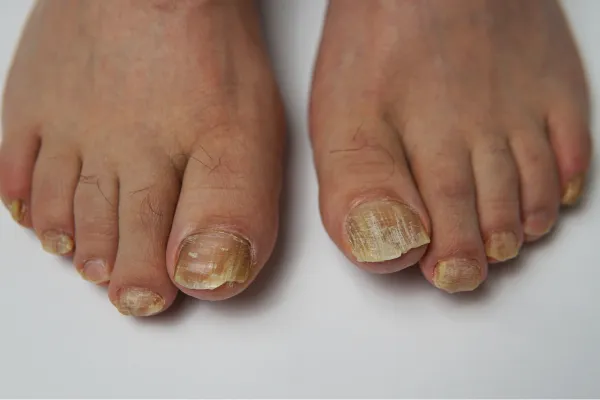
Top 5 Reasons Your Toenails Might Be Thick, Yellow or Crumbly
Toenails Acting Strange? Here's What Could Be Going On
Toenails aren’t something we usually think about—until they start looking a bit... off.
If you’ve noticed one or more toenails becoming thick, yellow, brittle, or flaky, you’re not alone. It’s one of the most common reasons people visit a podiatry clinic. And while it might feel embarrassing, the good news is: you’re not stuck with it.
Let’s look at the 5 most common causes of unusual toenails—and how to fix them.
1. Fungal Nail Infection (Onychomycosis)
This is by far the most common reason people get thick, yellow, or crumbly toenails.
Fungal nail infections can start small—maybe just a bit of white discolouration at the edge of your nail—but over time, the nail becomes:
Thickened
Yellow, brown, or even greenish
Brittle or crumbly at the edges
Difficult (or painful) to cut
Fungus thrives in warm, moist environments like sweaty socks or shared showers at gyms and pools. It’s also contagious, so it can spread from one nail to another—or from other people.
The fix:
We offer several treatments at Peak Podiatry, including laser therapy, antifungal sprays, and professional nail debridement. The earlier you treat it, the better the results.
2. Trauma to the Nail
Stubbing your toe, dropping something heavy on it, or even tight shoes can cause damage to the nail bed. Sometimes the trauma is so minor you don’t even realise it happened—especially if you’re a runner or wear pointy shoes.
Over time, you may notice:
Thick or misshapen nails
Discolouration
Lifting of the nail from the nail bed
Pain when pressure is applied
The fix:
Mild trauma usually heals, but repeated damage can lead to long-term nail changes. A podiatrist can trim the nail properly, reduce thickness, and help prevent further issues.
3. Psoriasis or Skin Conditions
You might be surprised to learn that skin conditions like psoriasis or eczema can affect the nails too.
When that happens, the nail may:
Appear pitted or ridged
Become thick or flaky
Change colour
Separate from the nail bed
The fix:
Managing the underlying skin condition is key. We can work with your GP or dermatologist to support healthy nail care and prevent worsening changes.
4. Ageing
As we get older, it’s common for toenails to change in appearance. They may grow slower, become more brittle, or appear thicker than they used to. This is usually harmless—but can still be uncomfortable or hard to manage at home.
The fix:
Routine podiatry care can make a big difference. We use professional tools to safely reduce nail thickness and keep things tidy, so you don’t have to worry.
5. Poor Foot Hygiene or Footwear Choices
Wearing the same shoes every day, not drying your feet properly, or going barefoot in public showers can increase your risk of nail problems—especially fungal ones.
If your nails are looking discoloured and you also have foot odour, cracked skin, or athlete’s foot, hygiene could be part of the issue.
The fix:
Wash and dry your feet daily
Wear clean socks made of breathable material
Rotate your shoes and keep them dry inside
Use antifungal spray or powder if you’re prone to sweat
And if things still don’t improve—it’s time to book in for an expert look.
So, When Should You See a Podiatrist?
If your toenails:
Look worse over time
Feel painful or tender
Are difficult to cut at home
Don’t respond to creams or over-the-counter treatments
…it’s definitely time to get professional advice.
At Peak Podiatry, we’re not here to judge—we’re here to help. Whether you need treatment for a fungal infection, help with trimming thick nails, or just want to feel more confident wearing open-toed shoes again, we’ve got you covered.
Why Treating It Matters
Beyond appearance, nail problems can lead to:
Ongoing pain or discomfort
Difficulty walking or exercising
Risk of infection, especially if you have diabetes
Low confidence when wearing sandals or going barefoot
And while toenail issues aren’t usually urgent, they rarely fix themselves. The sooner you treat them, the easier it is.
Ready to Get Your Nails Back on Track?
Book an appointment at our Galway or Limerick clinic today. We’ll assess your nails, explain your options clearly, and help you take the first step toward healthier, happier feet.
Ask Robert And His Team
Fill in the form to request a Call From Our Team
Fill in the form to request a Call From Our Team
One of our team will call you for FREE and answer any questions or concerns you may have about your Foot Pain.
One of our team will call you for FREE and answer any questions or concerns you may have about your Foot Pain.
© Copyright 2022. Peak Podiatry All rights reserved.





